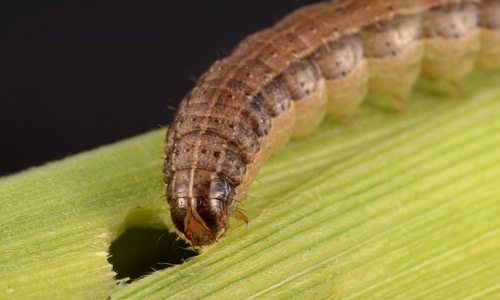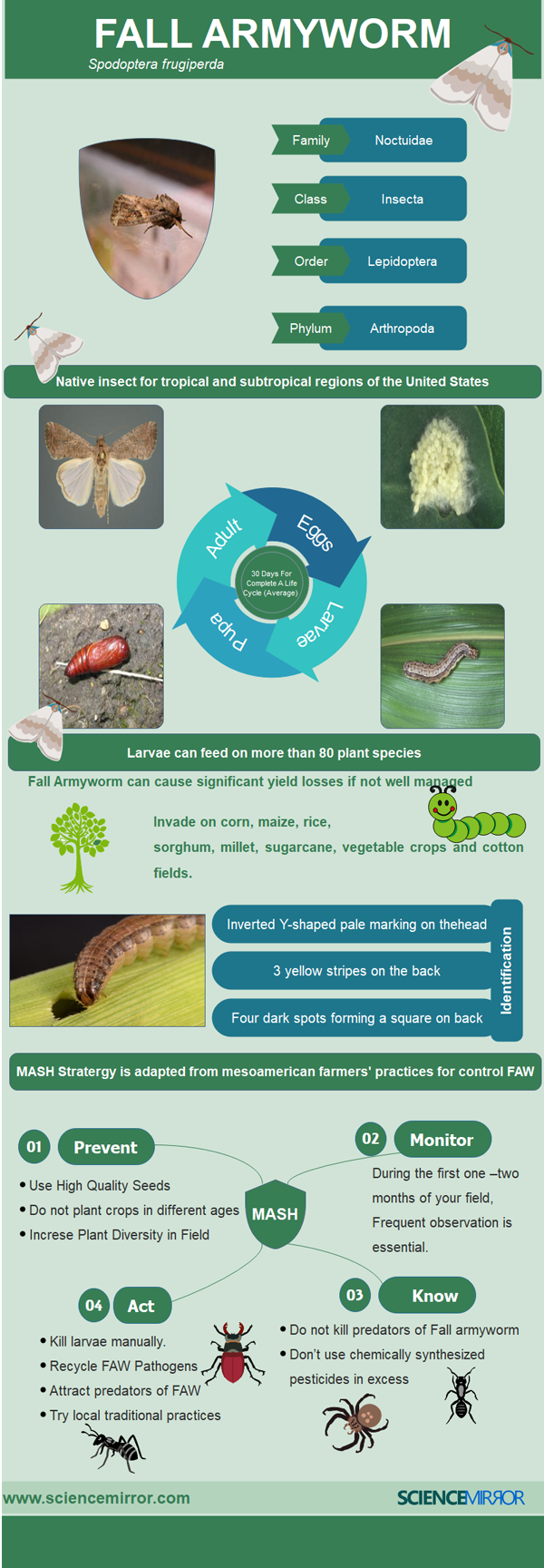Time to time we face lots of environmental challenges. It is very important to overcome with these environmental problems to secure our future.
Look about human history,
We have developed proper agricultural practices which evolved with hundreds of generations. There are several native practices region to region. All of these practices are adapted to face environmental challenges and ensure sustainability.
Now, there is a new emerging agricultural challenge for the whole world. That is Fall Armyworm. This is a viral pest and very hard to control with normal practices. If you have experience or seen the damage caused by this caterpillar, you know how worst that pest.
By the end of 2018, This pest has invaded sub-Saharan Africa and several Asian countries and vanished huge agricultural fields. It is able to feed on 80 crop plant varieties.
Although the Americans have been able to manage this pest for thousand years. Therefore, damages from this insect are stoppable.
Fall armyworm (Sena Caterpillar: Sri Lanka) is an insect scientifically known as Spodoptera frugiperda. It belongs to the Noctuidae family.
With this article lets’ know about current knowledge about this insect and explore possible ways to control with MASH strategy.
Identification of Fall Armyworm

( Photograph by Lyle J. Buss, University of Florida.)
Basically, it is a native insect for tropical and subtropical regions of the United States.
Identification of Fall Armyworm (FAW) is very important for management of damage. For this brief knowledge about the life cycle of FAW is required.
Its’ takes 30 days or more for complete the life cycle at 25 Celsius average temperature. As the other insects, we can identify four stages, Eggs, Larvae, Pupa and Adult.
Life Cycle of FAW
Eggs
Female adults lay dome-shaped eggs with 0.4mm diameter. In a mass, we can see 100 to 200 eggs. But average a female produce 1500 to 2000 eggs. New eggs are a pale green or white colour. After three days eggs become brown colour and hatch.
Larvae
Cleary, it can be seen in six stages in FAW’s larvae period. This stage takes 12 to 20 days. It depends on the environmental temperature. The young larvae are the greenish colour with a black head. When it matures the head colour into brownish.
The mature larvae have characteristics features. On the dark head, there is a white colour inverted Y shaped mark. This caterpillar has a rough or granular texture on the epidermis. But do not have microspines.
At the back, there are four dark spots arranging as a square. Three yellow colour strips can be found on the back.
Pupa
Reddish brown colour Pupa found in 2 to 8 cm depth soil. Use particles in soil with their silk to form Pupa. When there is hard soil they use leaf debris. This stage occurs about 8 to 9 days. In a colder environment, it can be as long as 20 days.
Adult
The nocturnal moth generally coloured with grey-brown and white. Wingspan length gets up to 4 cm. In the male moth, it can be seen triangular white marks at centre and tip of the wing. The female moth is pale colour than the male moth. The lifespan of this moth ranged between 10 to 21 days.

Damage from Fall Armyworm
As you know, the larvae stage of this insect causes huge damage to crops. Because their consumption rate is higher on crop plant. Especially corn fields face to huge problems with this pest.
The young larvae eat leaf tissue only on one side. But second and third larvae stages start to make holes on leaves. A mature larva only leaves ribs stalks of growing corn plants. All other parts are FAWs’ favourites.
It can find one to two larvae on a plant. They can reduce a considerable amount of yield or vanish the plant entirely.
The risk of with this caterpillar is, invade on crops that are essential for human daily consumption. The best examples are rice, maize, sugarcane, millet and vegetable crops.
MASH Strategy for control Fall Armyworm in the field.
The Mesoamerican farmers have shown how to control this pest with best practices. They are farming corn and other crops successfully with control of FAW and other pests. They have a good history and experiences.
This pest is new for most countries. So lack of knowledge for control makes FAW viral.
Is FAW already spread in your country? Look at the time,
It had taken a few months to vanish agriculture in the entire country. For example, in Sri Lanka within three months Fall armyworm invaded hole country including corn and vegetable fields.
Therefore, it is very important to have a good strategy for manage this pest. All countries should have a unique strategy for face FAW. because each country has deferent environmental conditions. But, it takes a long time to develop a strategy for a country.
As a short time solution, we can gain experiences from the Mesoamerican farming community. FAO already recommended their strategies.
FAO has developed a method for smallholders. For our easy access lets’ name it as MASH Strategy. (Mesoamerican Small Holders’ Strategy). If you are suffering from FAW you can try this strategy until your government give a solution.
MASH Strategy has four main parts. They are Prevent, Monitor, Know and Act.
Prevent
Before starting your cultivation it is very important to get prevention actions. For prevention, follow the following steps.
- High-quality seed usage.
Don’t use cheap low-quality seeds. Because those seeds make low healthy plants. Always use certified high-quality seeds in your field.
Fall armyworm feed on low healthy plants easily. Therefore, start with good seeds.
- Don’t plant in different ages.
In your field, plant seeds in one time. Don’t plant in different times in different plots.
Female moths are favour to lay eggs on younger plants. If your field has younger plants in one section, it will attract more moths.
It is very important to discuss with your farming community and start cultivation in the field at the same time with others.
- Mixed Plants.
As a smallholder, you can practice this easily. Increase plant diversity in your fields. If you are cultivating corn, consider planting cassava or yams like moths repelling species.
Look for your country’s traditional farming practices. Then you can know about more moth repelling species.
Having different plant species in your field helps to attract wasps like enemies of FAW.
Monitor
During the first one –two months of your field, Frequent observation is essential.
Look for the general health of your plants every three or four days. Certify your plants don’t have the colour changed or larvae damaged leafs and eggs or larvae on plants. Ensure there are ants, wasps like FAWs’ enemies present in the field. A large reduction of those animals shows red light for FAW attack.
Know
Update with current knowledge of pest management. It is a very important step before the act.
Do not kill predators of Fall armyworm. Commonly known predators are Ants, Wasps, earwigs, Ladybird beetles, ground beetles, flower bugs, spiders as well as birds and bats.
Don’t use chemically synthesized pesticides in excess. Because those pesticides are harmful for above helpers for manage FAW attack. Damages from those animals are negligible compared to FAW damages.
Act
When doing monitoring if you find signs of the pest. You can do.
- Kill larvae manually.
If your field has young larvae or eggs collect them manually and destroy. It is very important for preventing larvae penetration into the soil for becoming a pupa.
- Recycle FAW Pathogens.
Walk through your field and collect death larvae. Crush them and dilute with water. Then spray them back to field.
This step helps to spread bacteria, fungus, virus-like FAW harmful pathogens in your field.
- Attract predators of FAW
Spray sugar mixed water into your field. It will attract ants, wasps like predators and help to control this harmful pest.
- Try local traditional practices.
There are traditional practices in local level to control pests. Within them, usage of ash, lime, salt sand, extract from marigold flowers, hot peppers have shown good responses to killing FAWs.
Instead of chemically synthesized pesticides use those traditional methods to kill FAWs.
This strategy is based on biological control methods. And this is a very good practice for small farmers to manage this pest within their community because it has shown good results in Mesoamerican regions from hundreds of years.
Although If you are a large scale farmer this method will not be suitable. You may have to go chemically synthesized pesticides. But try to add some methods from MASH strategy. As an example, you can cultivate some moth repel plants in your field.
If your region is new for this pest starts with MASH strategy. Share this post and aware others. Practice as a community.
Share your experiences with Fall Armyworm. Experiences are very important to control these type of pest. Specially if you have good traditional practice comment below. It will help other farmers.



